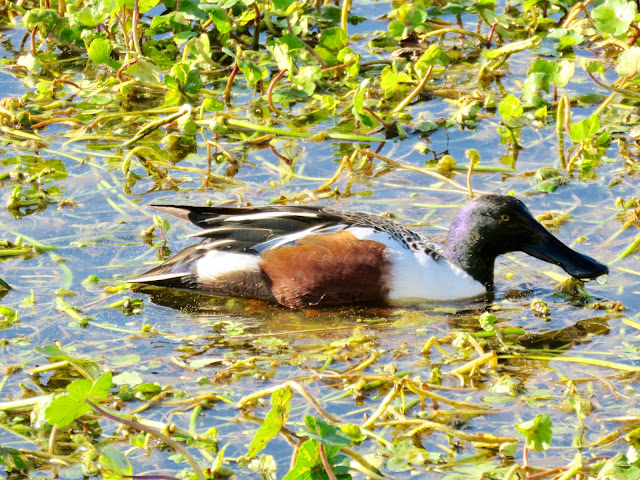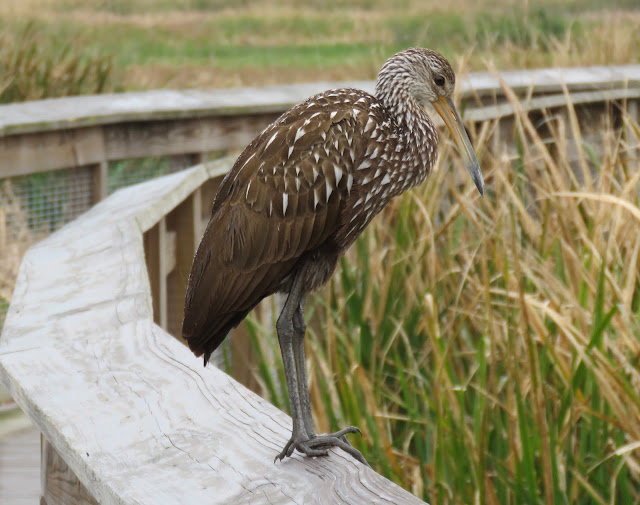 |
| We don't call him "Off-Road Rowan" for nothing. |
It's my opinion that March is the most boring month of the year in Florida. Simply put, nothing much is happening. Many of the winter visitors are leaving. The sparrows and ducks become less numerous, and large flocks of Sandhill Cranes circle overhead before turning to the north for the summer. On the other hand, migration hasn't really taken hold yet. Sure there are the early arriving Northern Parulas looking for a safe place to breed and raise their young. True, Ruby-throated Hummingbirds show up mid-month and the first Swallow-tailed Kites grace us with their aerial acrobatics, but the waves of warblers and other neotropical migrants are waiting for April when the birding activity will shift into a much higher gear. But in March, we're playing a waiting game, so what's a birder to do? Fortunately, I had a three-part solution that made the first half of the month more enjoyable.
 |
| You can watch birds like this Northern Cardinal by looking out your window! |
The first part of my solution begins with a reminder that you can bird by looking out your own window. I've been happily involved with Project FeederWatch (PFW) for over a decade. This project in citizen science is sponsored by Cornell University. It asks participants to watch their bird feeders periodically from late fall through early spring. For two consecutive days you record whatever you see at your feeders, and you note the high and low temperatures and precipitation during the two days. You estimate the amount of time you spend looking at the feeders. Then you report the data to the PFW website. There is no minimum or maximum amount of time you can spend during the two days watching and counting birds. You can glance at the feeders when you get a chance, or you can use my approach. I plant myself on my back porch with a cup of coffee and some birding magazines and kill off a bunch of hours in quiet pleasure. The goal is to record and report the highest number of each species you see at one time at your feeders or water features. Then you take five or more days off and repeat. I love it!
 |
| The number of Brown Thrashers coming to my feeders increases every March |
And while the rest of the birding world is boring, my feeders explode with activity during March. The numbers of Chipping Sparrows and American Goldfinches swell from single birds to small flocks, devouring seed at an alarming rate! They're fattening up before the long journey to their summer breeding grounds. Local residents who don't regularly frequent feeders, also are preparing for breeding season, and the easy-to-get food of a feeder is too good to pass up.
 |
| This Yellow-rumped Warbler Is the most aggressive I've ever seen! |
Watching feeders has also taught me something about the behavior of various species. There are the grab-and-dash feeders like the Carolina Chickadee and Tufted Titmouse that grab a single seed and dash into the cover of a tree to crack it open and eat. But the House Finch and American Goldfinch are patient, sitting at a single feeder perch for an extended amount of time until they get their fill. Chipping Sparrows can feed on the ground in a large group in relative peace, but too many bodies in a small platform feeder brings out displays of temper.
 |
| I watched this Downy Woodpecker successfully fight off the aggressive Yellow-rumped Warbler |
And this winter I had two oddities - at least for me. First, I had an Eastern Phoebe spend the winter in my yard eating suet. I've had Phoebes stop in my yard on occasion for years, but this one was here every day for months. And rather than chasing insects all day, it sat on the top of a raccoon baffle and ate the suet crumbs that fell from the feeder above. That was a new behavior for me, and I enjoyed watching it. And then there was the Yellow-rumped Warbler pictured up above. This bird selected two of my five suet feeders and decided that they were his domain. He spent every day defending those two feeders against birds of every species, harassing them constantly until they got tired or intimidated and flew off. Only the Brown Thrasher and the woodpeckers (like the Downy pictured directly above) resisted his aggression. But Carolina Wrens, Gray Catbirds, Yellow-throated Warblers, and other Yellow-rumps scattered before his fury.
You might think I'm easily amused, but Project FeederWatch kept me very happy for a hunk of March.
 |
| And where there is water, you attract birds that don't typically eat at feeders, like this Blue Jay. |
The second part of the solution that "saved" the early part of March was the opportunity to see a new park that I think has the potential to become a real treasure in the months ahead. In January, Little Orange Creek Preserve near the town of Hawthorne opened its gates for the first time. While the park is still in its infancy, and much has yet to be done to help it achieve its full potential, I think it's going to be a great birding hot spot, especially during fall migration. The park straddles Little Orange Creek, and the current nature trail skirts its eastern edge. So as you walk along the trail, on one side you have a creek and a series of marshes with its own water-related species. Meanwhile, on your other side is some rolling hills with newly planted longleaf pine, some open meadows, and some mixed pine and deciduous woods. The trail actually marks the boundary between very different habitats which have the potential to increase the bird diversity significantly.
 |
| In one of the marshes, this Little Blue Heron ignored us while feeding along Little Orange Creek |
I visited the park with my good friend and birding mentor Rex Rowan. I don't see Rex often enough, so the morning would have been fun even without birds. However, we tallied about 42 species for the morning while we slogged our way through muddy marsh edges and scrambled over rolling hills. On the watery side we saw Great and Little Blue Herons, Great and Snowy Egrets, Common Yellowthroats and Swamp Sparrows. On the dry side we saw Hermit Thrush, Ovenbird, Yellow-throated and Black-and-White Warblers, and so on.
 |
| This House Wren was not amused by our presence and scolded us loudly until we left him alone. |
The park was also great for woodpeckers. While there we saw or heard Red-bellied, Downy and Pileated Woodpeckers as well as a couple of Northern Flickers. In one spot we heard persistent drilling, but couldn't find the bird. Then a woodpecker butt appeared and the Red-bellied Woodpecker pictured below backed out of a hole. It looks like he was getting a nest ready for his future family!
 |
| Those two pointed tail feathers are really stiff, providing the woodpecker with a brace to keep himself steady while drilling. |
Here's one shot of the picturesque Cantwell Trail at Little Orange Creek Preserve. The creek is just over the edge of the trail on the left, and a mixed forest graces the right.
The final part of my solution to the March blahs was to visit Sweetwater Wetlands Park in Gainesville while I was NOT leading a field trip. It seems that every time I've been there recently, I've been leading a group. While I enjoy doing that a lot, going alone allows me to bird at my leisure and go where I want while not having to worry about anyone else. I'm also free to take as many photos as I want. I went there one very cold and breezy morning and had a wonderful time! Okay, it was cold by Florida's standards - about 37 degrees - and not the cold I grew up with in northeastern Pennsylvania. Still, it was cold enough. Cold or not, Sweetwater never lets me down, and that day was no exception.
 |
| Tree Swallows feeding over Cell One at Sweetwater Wetlands Park |
As soon as I arrived, I was greeted with the sight of dozens of Tree Swallows dashing and darting around Cell One. I've been wanting to experiment with the Sports setting on my camera, and this was a great chance. I adjusted the setting and pointed my camera at one spot where the swallows seemed to be focusing. I pushed the button and let the camera fire away, rapidly taking a bunch of photos. Eventually most of them got tossed out, but a few of the photos looked pretty good. I love the electric blue on the backs of the Tree Swallows when they're lit up by the sun!
Meanwhile, an American Coot blithely went about its business, ignoring both me and the swallows:
 |
| I'm not sure if that's food or nesting material, probably the former, but this American Coot is looking good! |
Just as I got to the boardwalk, I noticed this Palm Warbler hopping about just below my feet. I enjoyed taking the extra time to watch it going about its morning routine. Soon Palm Warblers will be leaving us, not to return until next winter.
Farther down the boardwalk I saw this Northern Shoveler (below). He has been here all winter, and it's wonderful to see his fresh breeding plumage beginning to emerge. Usually, male Northern Shovelers appear to have a deep green head. But with the right light and some added water from dipping his head for food, this guy looks more purple than green. It's not a great photo, but you can see the color on the back of his head.
And speaking of breeding plumage ... check out the color around the eye of this Anhinga. Wow! That turquoise is spectacular!
So, the solution to an otherwise boring March ... spending time watching my feeders, visiting a new place with an old friend, and visiting a great spot alone. Put them together, and the first half of March was a lot of fun!

























